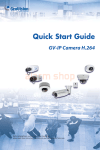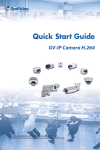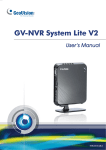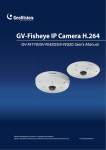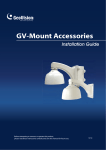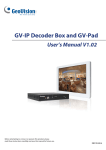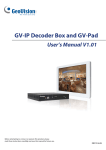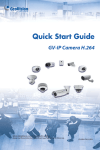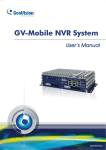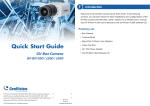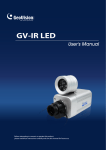Download Quick Start Guide - TVprzemyslowa.pl
Transcript
Quick Start Guide GV-IP Camera H.264 Before attempting to connect or operate this product, please read these instructions carefully and save this manual for future use. © 2012 GeoVision, Inc. All rights reserved. Under the copyright laws, this manual may not be copied, in whole or in part, without the written consent of GeoVision. Every effort has been made to ensure that the information in this manual is accurate. GeoVision, Inc. makes no expressed or implied warranty of any kind and assumes no responsibility for errors or omissions. No liability is assumed for incidental or consequential damages arising from the use of the information or products contained herein. Features and specifications are subject to change without notice. Note: no SD/SDHC card slot or local storage function for Argentina. GeoVision, Inc. 9F, No. 246, Sec. 1, Neihu Rd., Neihu District, Taipei, Taiwan Tel: +886-2-8797-8377 Fax: +886-2-8797-8335 http://www.geovision.com.tw Trademarks used in this manual: GeoVision, the GeoVision logo and GV series products are trademarks of GeoVision, Inc. Windows and Windows XP are registered trademarks of Microsoft Corporation. February 2012 For GV-CBW120 and GV-CBW220: This device complies with Part 15 of the FCC Rules. Operation is subject to the following two conditions: (1) this device may not cause harmful interference and (2) this device must accept any interference received, including interference that may cause undesired operation of the device. i Contents Introduction ..................................................................................v Options ........................................................................................xi Optional Accessories for Installation.......................................xii Note for Connecting to GV-System .........................................xiv Note for Adjusting Focus and Zoom ........................................xv Note for Installing Camera Outdoor ........................................xvi 1. Box Camera ..............................................................................1 1.1 Packing List................................................................................. 1 1.2 Overview ..................................................................................... 2 1.3 Accessory Installation ................................................................. 6 1.3.1 C-Mount Lenses ..................................................................6 1.3.2 Infrared Illuminators (GV-IR LED / GV-IR LED T2) .............8 1.4 Connecting the Camera ............................................................ 10 2. IR Arctic Box Camera ............................................................13 2.1 Packing List............................................................................... 13 2.2 Overview ................................................................................... 14 2.3 Installation................................................................................. 15 2.4 Connecting the Camera ......................................................... 19 2.4.1 Wire Definition ...................................................................19 3. Mini Fixed Dome & Mini Fixed Rugged Dome .....................21 3.1 Packing List............................................................................... 21 3.2 Overview ................................................................................... 22 GV-MFD110 ...............................................................................22 GV-MFD120 / 130 / 220 / 320 / 520 ...........................................23 LED Indicator..............................................................................24 GV-MDR120 / 220 / 320 / 520 ....................................................24 3.3 Installation................................................................................. 26 3.3 Installation................................................................................. 26 GV-MFD Series ..........................................................................26 GV-MDR Series..........................................................................28 3.4 Connecting the Camera ............................................................ 31 ii 3.4.1 Wire Definition ...................................................................31 3.4.2 Power and Network Connection ........................................32 3.4.3 Vehicle Installation ............................................................33 4. Bullet Camera .........................................................................35 4.1 Packing List............................................................................... 35 4.2 Overview ................................................................................... 36 4.3 Installation................................................................................. 37 4.3.1 Adjusting the Angles..........................................................38 4.3.2 Adjusting Lens and Inserting a Micro SD Card..................41 4.3.3 Inserting the Sun-Shield Cover..........................................43 4.4 Connecting the Camera ............................................................ 44 4.4.1 Wire Definition ...................................................................44 4.4.2 Connecting the Power Cable.............................................45 5. Vandal Proof IP Dome............................................................47 5.1 Packing List............................................................................... 47 5.2 Overview ................................................................................... 49 5.3 Installation................................................................................. 50 5.3.1 Hard-Ceiling Mount ...........................................................50 5.3.2 In-Ceiling Mount ................................................................55 5.3.3 L-Shaped Wall Mount........................................................58 5.4 Connecting the Camera ............................................................ 61 5.4.1 Wire Definition ...................................................................61 5.4.2 Connecting the Power Cable.............................................62 6. Fixed IP Dome ........................................................................63 6.1 Packing List............................................................................... 63 6.1.1 Packing List for Hard-Ceiling Mount ..................................63 6.1.2 Packing List for In-Ceiling Mount.......................................64 6.2 Overview ................................................................................... 65 6.3 Installation................................................................................. 67 6.3.1 Hard-Ceiling Mount ...........................................................67 6.3.2 In-Ceiling Mount ................................................................71 6.3.3 Wall-Surface Mount...........................................................74 iii 6.3.4 L-Shaped Wall Mount........................................................75 6.4 Connecting the Camera............................................................ 78 7. Cube & Wireless Cube Camera.............................................79 7.1 Packing List............................................................................... 79 7.2 Overview ................................................................................... 80 7.3 Installation................................................................................. 81 7.4 Connecting the Camera ............................................................ 83 8. Accessing the Camera...........................................................85 8.1 System Requirement ................................................................ 85 8.2 Accessing the Live View ........................................................... 86 8.2.1 Checking the Dynamic IP Address ....................................87 8.2.2 Configuring the IP Address................................................89 8.2.3 Configuring the Wireless Connection ................................91 8.3 Adjusting Image Clarity ............................................................. 94 8.3.1 Using Focus Adjustment Cap ............................................96 9. The Web Interface ..................................................................99 10. Upgrading System Firmware.............................................101 11 Restoring to Default Settings.............................................103 11.1 Using the Web Interface ....................................................... 103 11.2 Directly on the Camera ......................................................... 104 GV-BX110D..............................................................................104 GV-BX120D / 130D Series / 140DW / 220D Series / 320D Series / 520D-0 105 GV-MFD110 .............................................................................106 GV-MFD120 / 130 / 220 / 320 / 520 .........................................106 Mini Fixed Rugged Dome.........................................................107 Bullet Camera...........................................................................107 Vandal Proof IP Dome..............................................................108 Fixed IP Dome..........................................................................109 Cube Camera / Wireless Cube Camera ...................................109 iv Introduction Welcome to the GV-IPCam H.264 Quick Start Guide. In this quick guide, you will find information on the installation and basic configurations of the Box Camera, IR Arctic Box Camera, Mini Fixed Dome, Mini Fixed Rugged Dome, Bullet Camera, Vandal Proof IP Dome, Fixed IP Dome, Cube Camera and Wireless Cube Camera. Camera Model No. 1.3 MP H.264, D/N, Fixed Iris Varifocal Lens 1.3 MP H.264, D/N, Auto Iris GV-BX120D Varifocal Lens 1.3 MP H.264, Low Lux, D/N, Auto Iris, f: 2.8 ~ 12 mm, F/1.4, 1/3’’ CS Lens GV-BX130D-0 Varifocal Lens 1.3 MP H.264, D/N, Auto Iris, f: 2.8 ~ 12 mm, F/1.4, 1/3’’ CS Lens GV-BX130D-1 Fixed Lens 1.3 MP H.264, D/N, Fixed Iris, f: 4 mm, F/1.5, 1/3’’ CS Lens GV-BX140DW Varifocal Lens 1 MP H.264, D/N WDR, Fixed Iris, f: 2.8 ~ 12 mm, F/1.4, 1/3’’ CS Lens GV-BX110D Box Camera Description Fixed Lens v Camera Box Camera Model No. Description GV-BX220D-0 2 MP, H.264 D/N, Auto Iris, f: 2.8 ~ 8.5 mm, F/1.4, 1/3” CS Lens GV-BX220D-1 2 MP, H.264 D/N, Auto Iris, f: 3.1 ~ 8 mm, F/1.2, 1/3’’ CS Lens GV-BX220D-2 2 MP, H.264 D/N, Auto Iris, f: 2.8 ~ 6 mm, F/1.3, 1/3’’ CS Lens GV-BX220D-3 GV-BX320D-0 vi Varifocal Lens 2 MP, H.264 D/N, Auto Iris, f: 2.8 ~ 12 mm, F/1.4, 1/3’’ CS Lens 3 MP, H.264 D/N, Auto Iris, f: 3.1 ~ 8 mm, F/1.2, 1/3’’ CS Lens GV-BX320D-1 3 MP, H.264 D/N, Auto Iris, f: 2.8 ~ 6 mm, F/1.3, 1/3’’ CS Lens GV-BX520D-0 5 MP, H.264 D/N, Manual Iris, f: 4.5 ~ 10 mm, F/1.6, 1/2’’ CS Lens Camera IR Arctic Box Camera Mini Fixed Dome Model No. Description GV-BX120D-E 1.3 MP, H.264, Low Lux, D/N, Auto Iris, f: 2.8 ~ 12 mm, F/1.4, 1/3’’ CS Lens GV-BX220D-E Varifocal Lens GV-BX320D-E 2 MP, H.264 D/N, Auto Iris, f: 2.8 ~ 6 mm, F/1.3, 1/3’’ CS Lens 3 MP, H.264 D/N, Auto Iris, f: 2.8 ~ 6 mm, F/1.3, 1/3’’ CS Lens GV-BX520D-E 5 MP, H.264 D/N, Manual Iris, f: 4.5 ~ 10 mm, F/1.6, 1/3’’ CS Lens GV-MFD110 1.3 MP H.264, Color, Fixed Iris GV-MFD120 1.3 MP, H.264, Low Lux Color, Fixed Iris GV-MFD130 1.3 MP, H.264, Color, Fixed Iris GV-MFD220 Fixed Lens 2 MP, H.264, Color, Fixed Iris GV-MFD320 3 MP, H.264, Color, Fixed Iris GV-MFD520 5 MP, H.264, Color, Fixed Iris GV-MDR520 5 MP H.264, Color, Fixed Iris vii Camera Mini Fixed Rugged Dome Bullet Camera viii Model No. Description GV-MDR120 1.3 MP Low Lux H.264, Color, Fixed Iris GV-MDR220 Fixed Lens 2 MP H.264, Color, Fixed Iris GV-MDR320 3 MP H.264, Color, Fixed Iris GV-MDR520 5 MP H.264, Color, Fixed Iris GV-BL110D 1.3 MP H.264, Auto Iris GV-BL120D GV-BL130D Varifocal Lens 1.3 MP H.264, Low Lux, Auto Iris 1.3 MP H.264, Auto Iris GV-BL220D 2 MP H.264, Auto Iris GV-BL320D 3 MP H.264, Auto Iris Camera Model No. Description GV-VD120D (IK10+, Transparent Cover) GV-VD121D 1.3 MP H.264, Low Lux, Auto Iris (IK10+, Smoked Cover) GV-VD122D (IK7, Transparent Cover) GV-VD123D (IK7, Smoked Cover) GV-VD220D (IK10+, Transparent Cover) Vandal Proof IP Dome GV-VD221D (IK10+, Smoked Cover) Varifocal Lens 2 MP H.264, Auto Iris GV-VD222D (IK7, Transparent Cover) GV-VD223D (IK7, Smoked Cover) GV-VD320D (IK10+, Transparent Cover) GV-VD321D (IK10+, Smoked Cover) 3 MP H.264, Auto Iris GV-VD322D (IK7, Transparent Cover) GV-VD323D (IK7, Smoked Cover) ix Camera Model No. Description GV-FD120D Fixed IP Dome GV-FD220D Varifocal Lens GV-FD320D Cube Camera Wireless Cube Camera GV-CB120 GV-CB220 GV-CBW120 GV-CBW220 Fixed Lens 1.3 MP H.264, Low Lux, Auto Iris 2 MP H.264, Auto Iris 3 MP H.264, Auto Iris 1.3 MP H.264, Fixed Iris 2 MP H.264, Fixed Iris 1.3 MP H.264, Wireless Fixed Iris 2 MP H.264, Wireless Fixed Iris For a detailed user’s manual, see GV-IPCam H.264 User’s Manual on the software CD. x Options Optional devices can expand your camera’s capabilities and versatility. Contact your dealer for more information. Device Description A mountable infrared LED device that improves image performance of Box Cameras under low GV-IR LED light conditions. Note that the GV-IR LED is only compatible with GV-BX110D and GV-IR LED T2 is compatible with GV-BX120D / 130D Series / 140DW / 220D Series / 320D Series / 520D-0. GV-PA191 PoE Adapter The GV-PA191 PoE adapter is designed to provide power and network connection to the cameras over a single Ethernet cable. xi Optional Accessories for Installation For wall pendant mount of GV-Vandal Proof IP Dome or GV-Fixed IP Dome, purchase one of the Wall Pendant Tube and the corresponding mounting kit (GV-Mount901 or GV-Mount902) below. Model No. Description GV-Mount200 Wall Pendant Tube Detail Dimensions (L x W x D) 225 x 140 x 250 mm / 8.9 x 5.5 x 9.8 in Weight: 900 g / 1.98 lb GV-Mount201 Wall Pendant Tube Dimensions (L x W x D) 197.67 x 109 x 274.25 mm / 7.8 x 4.3 x 10.8 in Weight: 600 g / 1.32 lb GV-Mount202 Wall Pendant Tube Dimensions (L x W x D) 193.08 x 98 x 310.5 mm / 7.6 x 3.9 x 12.2 in Weight: 600 g / 1.32 lb xii Model No. Description GV-Mount900 Wall Mount Bracket Detail For L-shaped wall mount of Vandal Proof IP Dome and Fixed IP Dome. Dimensions 154 x 108 x 50 mm / 6.1 x 4.3 x 2 in GV-Mount901 GV-VD Series Dome Housing Dimensions ø 186 x 97.5 mm / ø 7.3 x 3.8 in Weight: 600 g / 1.32 lb GV-Mount902 GV-FD Series Dome Housing Dimensions ø 186 x 97.5 mm / ø 7.3 x 3.8 in Weight 600 g / 1.32 lb xiii Note for Connecting to GV-System The GV-IPCAM H.264 is designed to work with GV-System, a hybrid or digital video management system. Note the following when GV-IPCAM H.264 is connected to GV-System: 1. Normally, the images are recorded to the memory card inserted in the Box Camera, Mini Fixed Dome (except GV-MFD110), Mini Fixed Rugged Dome, Bullet Camera, Vandal Proof IP Dome, Fixed IP Dome, Cube Camera and Wireless Cube Camera. Once the camera is connected to GV-System for video management or the camera’s Live View is accessed through the Web browser (see 7. Accessing the Camera in the Quick Start Guide), the recording to the memory card will be stopped and the recording will be taken control by GV-System. When the connection between the camera and GV-System is interrupted, the recording to the memory card will be resumed to back up the images on the camera. 2. Once the camera is connected to GV-System, the resolution set on GV-System will override the resolution set on the camera’s Web interface. You can only change the resolution settings through the Web interface when the connection to GV-System is interrupted. xiv Note for Adjusting Focus and Zoom When adjusting the Focus and Zoom Screws (on Box Camera, IR Arctic Box Camera, Mini Fixed Dome, Bullet Camera, Vandal Proof IP Dome and Fixed IP Camera), please do not over tighten the Focus and Zoom screws. The screws only need to be as tight as your finger can do it; don't bother using any tools to get them tighter. Doing so can damage the structure of lens. For example, Bullet Camera Fixed IP Camera xv Note for Installing Camera Outdoor When installing the IR Arctic Box Camera, Bullet Camera, Vandal Proof IP Dome or Mini Fixed Rugged Dome outdoor, be sure that: 1. The camera is set up above the junction box to prevent water from entering the camera along the cables. 2. Any PoE, power, audio and I/O cables are waterproofed using waterproof silicon rubber or the like. xvi 1. Box Camera 1.1 Packing List Box Camera Terminal Block Fixed Focal or Varifocal Megapixel Lens Pin Wrench (for GV-BX110D only) C-mount Lens Adapter (for GV-BX110D only) Six Lens Rings (for GV-BX120D / 130D series / 220D series / 320D series / 520D) One Lens Ring (for GV-BX140DW only) Video Out Wire (not available for GV-BX110D) DC 12V Power Adapter GV-IPCAM H.264 Software CD GV-IPCAM H.264 Quick Start Guide GV-NVR Software DVD GV-NVR Quick Start Guide 1.2 Overview GV-BX110D Note: The Zoom Screw and Auto Iris Connector are only available in the varifocal model. 2 1 No. 1 2 Name Audio Out Audio In Box Camera Description Connects a speaker for audio output. Connects a microphone for audio input. Resets all configurations to factory default. See 11. Restoring to Default Settings later in the Quick Start Guide. Inserts a micro SD/SDHC card to store recording data. Connects to a portable monitor for setting the focus and angle of Box Camera during initial installation. Connects to I/O devices. For details, see I/O Terminal Block, Box Camera chapter GV-IPCam H.264 User’s Manual on the software CD. Connects to a 10/100 Ethernet or PoE. Connects to power. 3 Default 4 Memory Card Slot 5 Video Out 6 I/O Terminal Block 7 8 LAN / PoE DC 12V Connector 9 Status LED Reflects system status of the camera. See the table below. 10 Zoom Screw Adjusts the zoom of the camera. 11 Focus Screw Adjusts the focus of the camera. 12 Microphone 13 Auto Iris Connector Records the sounds. If the varifocal lens is in use, plug the iris control cable to the connector. Note that Auto Iris Connector is not functional in the fixed focal GV-BX110D. Status LED Red Light ON Flashing Red and Green Lights Green Light ON Description The system powers on and succeeds to boot up. The camera is ready for use with network connectivity. Error occurs on the system. 3 GV-BX120D / 130D Series / 140DW / 220D Series / 320D Series / 520D-0 Note: 1. The Light Sensor is only available in GV-BX140DW. Keep the Light sensor unobscured for accurate light detection. 2. The Iris Screw is only available for GV-BX520D-0. 3. The Zoom Screw is not available for GV-BX110D (fixed lens model) and GV-BX130D-1. No. 4 Name Description 1 Video Out Connects to a portable monitor for setting the focus and angle of Box Camera during initial installation. 2 Memory Card Slot Inserts a micro SD/SDHC card to store recording data. 3 Audio Out Connects a speaker for audio output. 4 Audio In Connects a microphone for audio input. 5 I/O Terminal Block Connects I/O devices. For details, see I/O Terminal Block, Box Camera chapter, GV-IPCam H.264 User’s Manual on the software CD. 6 Power LED Indicates the power is supplied. 1 No. Box Camera Name Description 7 Auto Iris Connector Plug the iris control cable to the connector. Note that Auto Iris Connector is not functional in GV-BX130D-1, GV-BX140DW and GV-BX520D-0. 8 DC 12V Port Connects to power. 9 LAN / PoE Connects to a 10/100 Ethernet or PoE. 10 Default Resets all configurations to factory default. See 11. Restoring to Default Settings later in the Quick Start Guide. 11 Light Sensor Detects light to switch between day and night mode. 12 Focus Screw Adjusts the focus of the camera. 13 Iris Screw Adjusts the iris of the camera 14 Microphone Records the sounds. 15 Zoom Screw Adjusts the zoom of the camera 16 Status LED Turns on when the unit is ready for use. 5 1.3 Accessory Installation 1.3.1 C-Mount Lenses When you use a C-mount lens, it requires a certain distance from the camera’s imaging chip to focus the lens. Mount the supplied C-mount lens adapter / lens ring to the camera, and then attach the lens onto the camera body. GV-BX110D Install the supplied C-mount lens adapter to extend focal length for GV-BX110D as illustrated below. C-mount lens adapter 6 1 Box Camera GV-BX120D / 130D Series / 140DW / 220D Series / 320D Series / 520D-0 Three type of lens rings are provided for GV-BX120D / 130D Series / 220D Series / 320D Series / 520D-0: 0.188 mm (transparent color) x 2 0.125 mm (black color with a glossy surface) x 2 0.254 mm (black color with a matt surface) x 2 For GV-BX140DW, a 0.125 mm lens ring is provided. Note: These lens rings are specially designed for varifocal models of GV-BX120D / 130D Series / 140DW / 220D Series / 320D Series / 520D-0. Besides the supplied lens rings, each varifocal model has already been installed with the necessary lens ring. 7 1.3.2 Infrared Illuminators (GV-IR LED / GV-IR LED T2) 1. Connect the infrared illuminator to the terminal block on the camera. See I/O Terminal Block, Box Camera chapter, GV-IPCam H.264 User’s Manual on the software CD, or GV-IR LED User’s Manual. 2. 3. Access the Web interface of the camera. Select Video and Motion, select Video Settings, select Streaming 1 and set the IR Check Function option to be Trigger by Input (for GV-IR LED) or Trigger IR by D/N (for GV-IR LED T2). GV-IR LED 8 1 Box Camera GV-IR LED T2 4. Click Apply. For Trigger by Input and Trigger IR by D/N functions, see the Video Settings section, Administrator Mode chapter in the GV-IPCam H.264 User’s Manual in the software CD. 9 1.4 Connecting the Camera The Box Camera is designed for indoor use. Please make sure the installing site is shielded from rain and moisture. GV-BX110D 3 3 4 7 6 10 2 5 1 1. Box Camera If you are using the auto iris model, plug the iris control cable to the Auto Iris Connector on the camera. 2. Use a standard network cable to connect the camera to your network. 3. Optionally connect a speaker and an external microphone. 4. Optionally connect a monitor using a Video Out wire. Enable this function by selecting the signal format at the TV Out field on the Web interface. See TV Out setting, in the Video Settings section, Chapter 12, GV-IPCam H.264 User’s Manual on the software CD. 5. Connect power using one of the following methods: 6. plugging the supplied power adapter to the DC jack. using the Power over Ethernet (PoE) function and the power will be provided over the network cable. Optionally connect to input / output devices or an infrared illuminator. For details, see Infrared Illuminator and I/O Terminal Block, Chapter 2, GV-IPCam H.264 User’s Manual on the software CD. 7. The status LED of the camera will be red. 8. You are ready to access the live view and adjust the image clarity . See 8. Accessing the Camera in the Quick Start Guide. 11 GV-BX120D / 130D Series / 140DW / 220D Series / 320D Series / 520D-0 1. If you are using the auto iris model, plug the iris control cable to the Auto Iris Connector on the camera. 2. Use a standard network cable to connect the camera to your network. 3. Optionally connect a speaker and an external microphone. 4. Optionally connect a monitor using a Video Out wire. Enable this function by selecting the signal format at the TV Out field on the Web interface. See TV Out setting, in the Video Settings section, Chapter 12, GV-IPCam H.264 User’s Manual on the software CD. 5. Optionally connect to input / output devices or an infrared illuminator. For details, see Infrared Illuminator and I/O Terminal Block, Chapter 2, GV-IPCam H.264 User’s Manual on the software CD. 6. Connect power using one of the following methods: plugging the supplied power adapter to the power port. using the Power over Ethernet (PoE) function and the power will be provided over the network cable. 7. The status LED of the camera will be on. 8. You are ready to access the live view and adjust the image clarity. See 8. Accessing the Camera in the Quick Start Guide. 12 2. IR Arctic Box Camera 2.1 Packing List IR Arctic Box Camera Screw Anchor x 4 Screw x 4 Washer x 4 Big Torx Wrench Small Torx Wrench Silica Gel Bag x 2 Sticker x 2 GV-PA481 GV-PA481 Power Cord GV-IPCAM H.264 Software CD GV-IPCAM H.264 Quick Start Guide GV-NVR Software DVD GV-NVR Quick Start Guide 2.2 Overview Note: The Iris Screw (no. 7) is only available in GV-BX520D-E. No. 1 2 3 4 5 6 7 14 Name Silica gel bag IR power plug Focus Screw Module screw Status LED Zoom Screw Iris Screw Description Desiccant that keeps the camera housing dry. Supplies power to the built-in IR LEDs. Adjusts the focus of the camera. Holds the module in place. Turns on when the unit is ready for use. Adjusts the zoom of the camera. Adjusts the iris of the camera. 2 Box Camera 2.3 Installation The IR Arctic Box Camera is designed for outdoor use. 1. Mark the installation site and drill four holes for screw anchors. 2. Insert the supplied screw anchors. 3. Secure the camera to the wall using the supplied washers and screws. 4. Connect the camera to the network and supply power via the PoE cable. See 2.4 Connecting the Camera. 5. Access the live view. See 8.2 Accessing the Live View in the Quick Start Guide. 6. Based on the live view, adjust the angle of the camera. Loosen the indicated screw with the supplied big torx wrench and adjust the joint. 15 Tilt Adjustment Pan Adjustment 7. Based on the live view, adjust the image clarity using the GV-IP Device Utility program. For details, see 8.3 Adjusting Image Clarity in the Quick Start Guide. Unscrew the cover with the supplied small torx wrench. 16 2 Box Camera Hold the connectors and unplug them. Important: Unscrew and remove the cover carefully. Pulling the cover off may cause damages to the inner wiring of the camera. Adjust the focus, zoom and iris screws. 17 8. Replace the silica gel bag. Paste the sticker to the front side of the silica gel bag. Press the sticker several times to make sure it adheres properly and paste the silica gel bag to the indicated place. Important: 1. Be sure that the new silica gel bag is concealed in the camera housing within 2 minutes of exposing to open air. 2. To prevent the lens from fogging up, you must replace the silica gel bag every time you open the camera. The gel bag loses its effectiveness when the dry camera is opened. 9. 18 Refer to step 7 to plug the connectors and secure the camera cover. 2 2.4 Box Camera Connecting the Camera 2.4.1 Wire Definition No. Wire Color Definition 1 Black (thick) PoE 2 Black BNC TV out 3 Green RCA Audio Out 4 Pink RCA Audio In Follow the steps below to connect the camera: 1. Optionally connect a speaker (green) and an external microphone (pink). 2. Optionally connect a monitor using a Video Out wire. Enable this function by selecting your signal format at the TV Out field on the Web interface. See Video Settings section, Administrator Mode Chapter, GV-IPCam H.264 User’s Manual on the software CD. 19 3. Connect the camera’s cable to the GV-PA481 PoE adapter as illustrated below. The power and network will be supplied simultaneously. 4. The status LED of the camera will be on. Note: For using the IR Arctic Box Camera, ensure that you: 1. enable the IR LED function on the Web interface after loading the default settings. 2. disable the status LED to reduce reflection when a green light spot appears on the live view. For details, see Notice for Using the IR Arctic Box Camera section, IR Arctic Box Camera chapter, GV-IPCam H.264 User’s Manual on the software CD. 20 3. Mini Fixed Dome & Mini Fixed Rugged Dome 3.1 Packing List Mini Fixed Dome or Mini Fixed Rugged Dome Torx Wrench Self Tapping Screw x 2 Screw Anchor x 2 Cable Stopper x 1 Installation Sticker (for GV-MDR series only) Silica Gel Bag x 2 (for GV-MDR series only) Ferrite core for vehicle installation 3-pin Terminal Block (for GV-MFD120 / 130 / 220 / 320 / 520 only) DC 12V Power Adapter (for GV-MFD120 / 130 / 220 / 320 / 520 only) GV-IPCAM H.264 Software CD GV-IPCAM H.264 Quick Start Guide GV-NVR Software DVD GV-NVR Quick Start Guide 3.2 Overview GV-MFD110 No. 22 Name 1 Default Button 2 3 4 5 6 7 Lens Focus Screw Tilt Screw Built-In Microphone Pan Screw Network/PoE Connection Description Resets the GV-MFD110 to factory default. See 10. Restoring to Default Settings later in the Quick Start Guide. Rotates the les right/left to adjust focus. Loosens the screw to adjust the focus. Loosens the screw to adjust the tilt angle. Provides one-way audio. Loosen the screw to pan. Connects the Network cable for power and Ethernet connection. 3 Mini Fixed & Rugged Dome GV-MFD120 / 130 / 220 / 320 / 520 5 No. Name 1 Default Button 2 3 4 5 6 Lens Tilt Screw Built-In Microphone Pan Screw LED Indicators 7 Memory Card Slot Description Resets the camera to factory default. See 10. Restoring to Default Settings later in the Quick Start Guide. Receives image inputs. Loosens the screw to adjust tilt angle. Provides one-way audio. Loosens the screw to pan. See LED Indicators below. Inserts a micro SD/SDHC card to store recording data. 23 LED Indicator LED Name 1. Link 2. ACT 3. PWR 4. SW RDY (Status) Description Turns only when the network is connected. Turns on when data are being transmitted. Turns on when power is on. Turns on when the system is ready. GV-MDR120 / 220 / 320 / 520 24 3 Mini Fixed & Rugged Dome No. 1 Name Silica gel bag 2 Conceal paper 3 4 5 6 7 Lens Rotation Disc Pan Disc Tilt Screw Built-In Microphone 8 Default Button 9 Power and status LED 10 LAN LED 11 Memory Card Slot Description Absorbs the moisture inside the camera. Prevents water or moisture from entering the camera. Receives image inputs. Rotates the camera lens. Pans the camera lens. Loosens to tilt the camera. Provides one-way audio. Resets the camera to factory default. See 10. Restoring to Default Settings later in the Quick Start Guide. Turns red when the power is on. Flashes orange light twice when the system is ready. Turns on when the network is connected. Inserts a micro SD/SDHC card to store recording data. IMPORTANT: In case of damage and possible condensation inside the camera housing, be sure not touch or remove the conceal paper. 25 3.3 Installation To install a Mini Fixed Dome, make sure the installing site is shielded from rain and moisture. GV-MFD Series 1. 2. Unscrew the housing cover using the supplied torx wrench. Put the camera on the desired location and make 2 marks on the ceiling for screw anchors. If you want to run the cables inside the ceiling, make a round mark with a diameter of 2.5 cm. 3. Drill the marks and insert the screw anchors. 4. Secure the Mini Fixed Dome to the ceiling with the self-tapping screws. 5. Connect the camera to network and power. For details, see 3.4 Connecting the Camera. 6. Access the live view. See 7.2 Accessing the Live View in the Quick Start Guide. 7. Adjust the angles based on the live view. Pan Adjustment 26 3 Mini Fixed & Rugged Dome Tilt Adjustment 8. For GV-MFD110, adjust image clarity using the GV-IP Device Utility program. For details, see 7.3 Adjusting Image Clarity in the Quick Start Guide. 9. Except for GV-MFD110, insert a Micro SD/SDHC card into the memory card slot. 10. Secure the housing cover using the supplied torx wrench. 11. Optionally conceal the cable opening with the supplied cable stopper. 27 GV-MDR Series 1. Paste the installation sticker on the desired location. The arrow should point toward the direction that the camera faces. 2. Drill one hole on each of the two curves for screw anchors. Drill the circle (30 mm in diameter) if you want to run the cable into the ceiling. 30 mm Drill a hole on each 3. Insert the screw anchors. 4. Unscrew the housing cover using the supplied torx wrench. 5. Secure the camera body to the ceiling with the self-tapping screws. 6. Connect the camera to PoE cable. 7. Access the live view. See 7.2 Accessing the Live View in the Quick Start Guide. 28 3 Mini Fixed & Rugged Dome 8. Adjust the angles based on the live view. Pan Adjustment Tilt Adjustment Rotational Adjustment 29 9. Insert a Micro SD/SDHC card into the memory card slot. 10. Secure the housing cover using the supplied torx wrench. 11. Optionally conceal the cable opening with the supplied cable stopper. 30 3 Mini Fixed & Rugged Dome 3.4 Connecting the Camera Refer to the wire definition and illustrations below to connect the power and network. 3.4.1 Wire Definition GV-MFD120 / 130 / 220 / 320 / 520 The data cable provides connections for power and network access. The wires are illustrated and defined below: No. 1 2 3 Wire Color Yellow Orange Gray Definition DC 12V+ GND PoE, Ethernet GV-MFD110 and GV-MDR120 / 220 / 320 / 520 Power and network connectivity is provided through a PoE cable. Wire Color Gray Definition PoE, Ethernet 31 3.4.2 Power and Network Connection For GV-MFD120 / 130 / 220 / 320 / 520, there are two ways to supply power to the camera: Use a Power over Ethernet (PoE) adapter to connect the camera to the network, and the power will be provided at the same time. Use the supplied 3-pin Terminal Block and power adapter. Follow the steps below to connect the Terminal Block and power adapter. 1. Insert the orange wire of the Mini Fixed Dome (except GV-MFD110) to the left pin and the yellow wire to the right pin of the supplied terminal block. 2. Connect the DC 12V Power Adapter to the 3-Pin Terminal Block. 3. Connect the camera to network using a network cable. 32 3 Mini Fixed & Rugged Dome 3.4.3 Vehicle Installation To install the Mini Fixed Rugged Dome on a vehicle, clip the ferrite core to the camera cable. The ferrite core must be attached as close as possible to the camera with the maximum distance of 15 cm. 33 34 4. Bullet Camera 4.1 Packing List Bullet Camera Lens (Megapixel and Built-In 16 IR LEDs) Self Tapping Screw x 3 Plastic Screw Anchor x 3 Torx Wrench x 2 Sun-Shield Cover Kit (1 Sun-Shield Cover, 2 Philips Head Screws, 2 Plastic Screw Spacers and 2 Hexagon Screws included) Silica Gel Bag x 2 3-Pin Terminal Block DC 12V Power Adapter GV-IPCAM H.264 Software CD GV-IPCAM H.264 Quick Start Guide GV-NVR Software DVD GV-NVR Quick Start Guide 4.2 Overview No. Name Description 1 Memory Card Slot Receives a Micro SD/SDHC memory card. 2 Zoom Screw Holds the zoom lens in place. 3 Focus Screw Holds the focus lens in place 4 Default Button Resets all configurations to factory default. See 11. Restoring to Default Settings later in the Quick Start Guide. 36 4 Bullet Camera 4.3 Installation The Bullet Camera is designed for outdoor use and can be mounted on ceiling and wall. 1. Slide the cable clamp to the camera base. 2. Install the Bullet Camera to the wall / ceiling. 3. Remove the protection sticker from the camera’s cover. 4. Connect the power, network and other cables to the camera. See 4.4 Connecting the Camera in the Quick Start Guide. 5. Access the live view. See 8.2 Accessing the Live View in the Quick Start Guide. 6. Adjust the angles of the camera body based on the live view. Three shafts can be adjusted. For details, see 4.3.1 Adjusting the Angles in the Quick Start Guide. 37 7. Loosen the camera’s cover, adjust the lens and focus, and insert a micro SD/SDHC card into the memory card slot. See 4.3.2 Adjusting Lens and Inserting a Micro SD Card in the Quick Start Guide. 8. Fasten the camera’s cover. 9. Install the sun-shield cover to the Bullet Camera. For details, see 4.3.3 Installing the Sun-Shield Cover in the Quick Start Guide. 4.3.1 Adjusting the Angles The Bullet Camera is designed to be adjustable in three shafts. Tip: The three shafts are designed to offer easy and flexible ceiling / wall mount installation. First Shaft You can adjust the camera body by 360 degrees to the right or the left. 1. Unscrew the panning lock screw with the torx wrench. Panning Lock Screw Torx Wrench 38 4 2. Bullet Camera Adjust the angle of camera body to the right or the left, and fasten the panning lock screw. Second Shaft You can adjust the camera body up and down by 90, 112.5, 135, 157.5 or 180 degrees by using the gears inside the camera body and the camera base. 1. 2. Unscrew the tilting lock screw with the torx wrench. Hold the camera body, and move the camera base to the right to separate the camera gears. 39 3. Adjust the angle of camera body to 90, 112.5, 135, 157.5 or 180 degrees. Then move the camera base to the left to combine the gears. 4. Fasten the tilting lock screw. Third Shaft You can adjust the camera base by 360 degrees. 1. 40 Unscrew the base fixing screw with the torx wrench. 4 2. Bullet Camera Adjust the angle of camera base, and fasten the base fixing screw. 0~360° 4.3.2 Adjusting Lens and Inserting a Micro SD Card To adjust the camera’s lens to produce a clear image and insert a micro SD card into the SD card slot, follow the steps below. 1. Loosen the camera’s cover. 2. Remove the silica gel bag. 41 3. Adjust for image clarity using GV-IP Device Utility. For details, see 8.3 Adjusting Image Clarity in the Quick Start Guide. 4. If you want to insert a micro SD/SDHC card, follow the steps below. 5. A. Loosen the fixing screw. B. Slightly pull out the camera module. C. Insert a micro SD/SDHC card into the memory card slot. D. Push the camera module back and fasten the fixing screw. Insert a new silica gel bag to the camera module and fasten the camera’s cover within 2 minutes of opening the silica gel bag package. IMPORTANT: To prevent the lens from fogging up, you must replace the silica gel bag every time you open the camera. The gel bag loses its effectiveness when the dry camera is opened. 42 4 Bullet Camera 4.3.3 Inserting the Sun-Shield Cover After setting up the Bullet Camera, now you can install the sun-shield cover to the camera. 1. 2. Fasten the hexagon screws either on top or below the camera. Put the sun-shield cover on top of hexagon screws. Make sure to aim the rear hexagon screw at the edge of the sun-shield cover’s aperture for optimal sun-shield performance. 3. Fasten the Philips head screws with the plastic screw spacers. 43 4.4 Connecting the Camera Connect your Bullet Camera to power, network and the cables needed. 4.4.1 Wire Definition The cable of the Bullet Camera is illustrated and defined below: No. Wire Color 1 Red Digital In 2 Brown DC 12V+ / AC 24V+ 3 Orange Digital Out 4 Black DC 12V- / AC 24V- 5 Yellow Ground 6 Red RCA Audio in 7 Green RCA Audio out 44 Definition 4 Bullet Camera 4.4.2 Connecting the Power Cable There are two ways to supply power to the Bullet Camera: Use a Power over Ethernet (PoE) adapter to connect the camera to the network, and the power will be provided at the same time. Use the supplied 3-pin Terminal Block and power adapter. Follow the steps below to connect the 3-pin Terminal Block and power adapter. 1. Insert the black wire of the Bullet Camera to the left-side pin of the 3-Pin Terminal Block and the brown wire to the right-side pin. 2. Connect the DC 12V Power Adapter to the 3-Pin Terminal Block. 45 46 5. Vandal Proof IP Dome 5.1 Packing List Vandal Proof IP Dome Silica Gel Bag x 2 Screw Anchor x 4 Torx Wrench x 1 Ceiling Screw x 4 Blue Screw x 3 T-Cap Screw x 3 Small Screw Cap x 3 T-Cap x 3 Plastic Clip x 3 Focus Adjustment Cap DC 12V Power Adapter 3-Pin Terminal Block GV-IPCam H.264 Software CD GV-IPCAM H.264 Quick GV-NVR Software DVD Start Guide GV-NVR Quick Start Guide Note: Focus Adjustment Cap is only needed and supplied for IK10+ models (GV-VD120D, 121D, 220D, 221D, 320D and 321D). 48 5 Vandal Proof IP Dome 5.2 Overview No. Name 1 Power LED 2 Status LED Description Turns on (green) when the power is on and turns off when there is no power supply. Turns on (green) when the system operates normally and turns off when system error occurs. Resets to factory default. For details, see 3 Default Button 11. Restoring to Default Settings in the Quick Start Guide. 4 5 Memory Card Slot Thread Lock Inserts a micro SD/SDHC card to store recording data. Locks the housing cover to the camera body to prevent the cover from falling. 6 Pan Disc 7 Tilt Screw Loosens to pan the camera. Loosen the screw to tilt the camera. 8 Rotational Screw Loosens to adjust the camera angle. 9 Zoom Screw Adjusts the zoom of the camera. 10 Focus Screw Adjusts the focus of the camera. 11 Silica Gel Bag Absorbs moisture in the camera body. 49 5.3 Installation The Vandal Proof IP Dome is designed for outdoors. With the standard packing, there are two ways to install the Vandal Proof IP Dome: hard-ceiling mount and in-ceiling mount. The optional accessory wall mount bracket can be purchased for L-Shaped Wall Mount. 5.3.1 Hard-Ceiling Mount 1. Unpack the camera package and take out the camera body. Unscrew the housing cover 50 5 Vandal Proof IP Dome Unscrew thread lock Unscrew the inner housing Take out the camera body 51 2. Mark the position of four screw holes on the desired installation location, and drill holes in the marked locations. Drill the ellipse part if you wish to put the wires through it. 3. Insert the screw anchors to the 4 holes on the ceiling. 4. Secure the back cover to the ceiling with 4 ceiling screws. wall 5. 6. Refer to step 1 to secure the camera body with inner housing. Thread the cable through the conduit entry at the side of the back cover. Alternatively pass the wires through the ellipse hole at the bottom of the back cover. 7. Connect the network and power cables to the camera. See 5.4 Connecting the Camera in the Quick Start Guide. 52 5 8. Vandal Proof IP Dome Access the live view. See 8.2. Accessing the Live View in the Quick Start Guide. 9. Adjust the camera to a desired angle as illustrated below. Tip: The 3-axis mechanism offers flexible and easy installation. Pan adjustment Tilt adjustment 53 Rotational Adjustment 10. Hold the focus adjustment cap on top of the camera view and adjust for image clarity using the GV-IP Device Utility program. For details, see 8.3 Adjusting Image Clarity in the Quick Start Guide. 11. Screw on the thread lock as shown in step 1. 12. Replace the silica gel bag on the camera body and secure the housing cover to the camera body (as shown in step 1) within 2 minutes of opening the silica gel bag package. Note: Adjust the black mask inside the housing cover to make sure the camera view is not obscured. 54 5 Vandal Proof IP Dome IMPORTANT: 1. To prevent the lens from fogging up, you must replace the silica gel bag every time you open the camera. The gel bag loses its effectiveness when the dry camera is opened. 2. Make sure the housing cover is properly secured to prevent water from entering and damaging the inner housing. 5.3.2 In-Ceiling Mount 1. Follow step 1 in the Hard-Ceiling Mount section to remove the housing cover, thread lock and back cover, and take out the camera body. 2. Cut out a circle with a diameter of 142 mm on the ceiling. 3. Insert a blue screw to the indicated holes on the camera body. 55 4. Screw in a plastic clip to the blue screw, hold it with one hand and use a screw driver to rotate the blue screw until the plastic clip moves half way down. 5. Secure a T-cap on top of the blue screw with a small screw cap and a T-cap screw. Do not tighten the small screw cap so that the plastic clip can move down freely. 6. 56 Repeat steps 4 and 5 for the other two blue screws. 5 Vandal Proof IP Dome 7. Insert the camera to the ceiling with the plastic screws moved inward. 8. Move the blue screws out and rotate the blue screw with a screw driver until the plastic clip and the bottom of the camera body clamps the ceiling tightly. 9. Connect the network and power cables to the camera. See 5.4 Connecting the Camera in the Quick Start Guide. 10. Access the live view. See 8.2 Accessing the Live View in the Quick Start Guide. 11. Follow steps 9 and 10 in the Hard-Ceiling Mount section to adjust the angle, focus and zoom of the camera. 12. Follow steps 11 and 12 in the Hard-Ceiling Mount section to secure the thread lock, replace the silica gel bag and secure the housing cover. 57 5.3.3 L-Shaped Wall Mount Optional accessories need to be purchased for L-shaped wall mount. 1. Take the wall mount bracket and make 2 marks on the wall for screw anchors. 2. 3. Drill the marks and insert 2 screw anchors. Insert the ceiling screws and leave enough distance (approximately 2 mm) to hang the wall mount bracket later. 58 5 4. Vandal Proof IP Dome Hang the wall mount bracket on the ceiling screws and push the wall mount bracket downward. Tighten the screws to the wall. 5. Follow step 1 in the Hard-Ceiling Mount section to remove the housing cover, thread lock and back cover, and take out the camera body. 6. Secure the back cover to the wall mount bracket with four short screws and big screw caps (both are supplied with the wall mount bracket). 7. Thread the cable through the conduit entry at the bottom of the back cover. 59 8. Follow step 1 in the Hard-Ceiling Mount section to secure the camera body with inner housing. 9. Connect the network and power cables to the camera. See 5.4 Connecting the Camera in the Quick Start Guide. 10. Access the live view. See 8.2 Accessing the Live View in the Quick Start Guide. 11. Follow steps 9 and 10 in the Hard-Ceiling Mount section to adjust the angle, focus and zoom of the camera. 12. Follow steps 11 and 12 in the Hard-Ceiling Mount section to secure the thread lock and the housing cover. 60 5 Vandal Proof IP Dome 5.4 Connecting the Camera Connect your Vandal Proof IP Dome to power, network and other cables. 5.4.1 Wire Definition The cables for Vandal Proof IP Dome are illustrated and defined below. No. Wire Color Definition 1 Black (thick) Shielding Ground 2 Black (thin) DC 12V- / AC 24V- 3 Red DC 12V+ / AC 24V+ 4 Orange Digital In 5 Brown Digital out 6 Yellow Ground 7 Red RCA Audio in 8 Green RCA Audio out 9 Black BNC TV out Note: To use the TV out function, connect the black BNC connector to a monitor and select your signal format (NTSC or PAL) at the TV Out field on the Web interface. For details, see Video Settings, Administrator Mode Chapter, GV-IPCam H.264 User’s Manual on the software CD. 61 5.4.2 Connecting the Power Cable There are two ways to supply power to the camera: Use a Power over Ethernet (PoE) adapter to connect the camera to the network, and the power will be provided at the same time. Use the supplied 3-pin terminal block and power adapter. Follow the steps below to connect the Terminal Block and the power adapter. 1. Insert the thin black wire of the Vandal Proof IP Dome to the left-side pin of the 3-Pin Terminal Block and the red wire to the right-side pin. 2. 62 Connect the DC 12V Power Adapter to the 3-Pin Terminal Block. 6. Fixed IP Dome 6.1 Packing List 6.1.1 Packing List for Hard-Ceiling Mount Fixed IP Dome Torx Wrench x 1 Mounting Plate x 1 Short Screw Anchor x 3 Ceiling Screw x 3 Plate Screw x 3 TV-out Wire DC 12V Power Adapter Sticker GV-IPCAM H.264 Quick Start Guide GV-IPCam H.264 Software CD GV-NVR Software DVD GV-NVR Quick Start Guide 6.1.2 Packing List for In-Ceiling Mount 64 In-Ceiling Housing Cover Mounting Plate x 1 Mounting Bracket x 3 Copper Pillar x 3 Copper Pillar Screw x 6 Bracket Screw x 3 Thread Lock Screw x 1 Housing Cover Thread Sticker (In-Ceiling Mount) 6 Fixed IP Dome 6.2 Overview No. 1 Name Description Focus Screw Adjusts the focus of the camera. 2 Zoom Screw Adjusts the zoom of the camera. 3 Rotational Screw Loosens to adjust the camera angle. 4 Tilt Screw Loosens the screw to tilt the camera. 5 Pan Disc Loosens to pan the camera. 6 Video Out Connects to a portable monitor for setting the focus and angle of Fixed IP Dome during initial installation. Inserts a micro SD/SDHC card to store 7 Memory Card Slot 8 Default Button 11. Restoring to Default Settings in the 9 Audio In Connects a microphone for audio input. 10 Audio Out Connects a speaker for audio output. 11 LAN / PoE Connects to a 10/100 Ethernet or PoE. recording data. Resets to factory default. For details, see Quick Start Guide. 65 No. Name Description Connects I/O devices. For details, see 12 I/O Terminal Block Fixed IP Dome chapter in the GV-IPCam H.264 User’s Manual on the software CD. 13 DC 12V Port Connects to power. Turns on (green) when the system 14 Status LED operates normally and turns off when system error occurs. 15 66 Power LED Turns on (green) when the power is on and turns off when there is no power supply. 6 Fixed IP Dome 6.3 Installation The Fixed IP Camera is designed for indoors. There are four ways to install the Fixed IP Camera: hard-ceiling mount, in-ceiling mount, wall-surface mount and L-shaped wall mount. 6.3.1 Hard-Ceiling Mount 1. Paste the supplied sticker onto a desired location on the ceiling. Drill the three red dots and the ellipse mark only if you wish to run the wires into the ceiling. 2. Unpack the camera package and take out the camera body. Use the torx wrench to loosen the housing cover at the front and the back 67 Take out the camera body 3. Secure the camera body and the mounting plate to the ceiling with the three ceiling screws. Ceiling mounting plate 4. Connect the network and power cables to the camera. See 6.4 Connecting the Camera in the Quick Start Guide. 5. Access the live view. See 8.2 Accessing the Live View in the Quick Start Guide. 68 6 Fixed IP Dome 6. Adjust the camera to a desired angle as illustrated below. Tip: The 3-axis mechanism offers flexible and easy ceiling / wall installation. Pan Adjustment Tilt Adjustment 69 Rotational Adjustment 7. Adjust for image clarity using the GV-IP Device Utility program. For details, see 8.3 Adjusting Image Clarity in the Quick Start Guide. Focus Screw Zoom Screw 8. Secure the housing cover as shown in step 2. Remove the indicated part when necessary. Note: Adjust the black mask inside the housing cover to make sure the camera view is not obscured. 70 6 Fixed IP Dome 6.3.2 In-Ceiling Mount 1. Follow step 2 in the Hard-Ceiling Mount section to remove the housing cover and take out the camera body. 2. Paste the supplied sticker onto a desired location on the ceiling and cut a circle on the ceiling along the edge of the sticker. 3. On the mounting plate, locate the 3 holes labeled as 1 and insert the 3 copper pillars from the back side. 4. From the side with the numbering, secure the copper pillars with 3 copper pillar screws. 71 5. Place the 3 mounting brackets at the indent next to the copper pillars (labeled as 2 on the mounting plate) and secure them using the 3 bracket screws. 6. Place the mounting plate on the camera body with the copper pillars inserted in the locations indicated below. The arrow on the mounting plate should be pointing toward the front of the camera. 7. From the bottom of the camera, secure the copper pillars using the 3 copper pillar screws. 8. Place the camera into the ceiling opening. 72 6 Fixed IP Dome 9. On the back side, make sure the black plastic clips are slightly above the ceiling board and pointing outward. Back Side Front Side 10. Tighten the bracket screws from the front side of the camera. 11. Connect the network and power cables to the camera. See 6.4 Connecting the Camera in the Quick Start Guide. 12. Access the live view. See 8.2 Accessing the Live View in the Quick Start Guide. 13. Follow steps 6 and 7 in the Hard-Ceiling Mount section to adjust the angle, focus and zoom of the camera. 14. Use the housing cover thread and the thread lock screw to attach the housing cover to the camera body. 73 15. Place the housing cover on the camera body with the GeoVision logo pointing toward the front of the camera. 6.3.3 Wall-Surface Mount 1. Follow step 2 in the Hard-Ceiling Mount section to remove the housing cover and take out the camera body. 2. Paste the supplied sticker onto a desired location on the wall. Drill the three red dots, and the ellipse mark only if you wish to run the wires into the wall. 74 6 Fixed IP Dome 3. Insert the short screw anchors and secure the camera and the mounting plate with three plate screws. 4. Connect the network and power cables to the camera. See 6.4 Connecting the Camera in the Quick Start Guide. 5. Access the live view. See 8.2 Accessing the Live View in the Quick Start Guide. 6. Follow steps 6 and 7 in the Hard-Ceiling Mount section to adjust the angle, focus and zoom of the camera. 7. Follow step 8 in the Hard-Ceiling Mount section to secure the housing cover. 6.3.4 L-Shaped Wall Mount Optional accessories need to be purchased for L-shaped wall mount. 75 1. Take the wall mount bracket and make 2 marks on the wall for screw anchors. 2. Drill the marks and insert 2 long screw anchors (supplied with the wall mount bracket). 3. Insert the wall mount screws (supplied with the wall mount bracket) and leave enough distance (approximately 2 mm) to hang the wall mount bracket later. 4. Hang the wall mount bracket on the wall mount screws and push the wall mount bracket downward. Tighten the wall mount screws to the wall. 5. Follow step 2 in the Hard-Ceiling Mount section to remove the housing cover and take out the camera body. 76 6 Fixed IP Dome 6. Secure the camera body to the wall mount bracket with three short screws (supplied with the wall mount bracket). 7. Connect the network and power cables to the camera. See 6.4 Connecting the Camera in the Quick Start Guide. 8. Access the live view. See 8.2 Accessing the Live View in the Quick Start Guide. 9. Follow steps 6 and 7 in the Hard-Ceiling Mount section to adjust the angle, focus and zoom of the camera. 10. Follow step 8 in the Hard-Ceiling Mount section to secure the housing cover. 77 6.4 Connecting the Camera 5 33 2 1. 2 1 4 Use a standard network cable to connect the camera to your network. 2. Optionally connect a speaker and an external microphone. 3. Optionally connect a monitor using a Video Out wire. Enable the function by selecting the signal format in the TV Out field in the Web interface. See TV Out setting, in the Video Settings section, Administrator Mode Chapter, GV-IPCam H.264 User’s Manual on the software CD. 4. Optionally connect to input / output devices. For details, see I/O Terminal Block, Fixed IP Dome Chapter, GV-IPCam H.264 User’s Manual on the software CD. 5. Connect power using one of the following methods: 6. 78 plugging the supplied power adapter to the power port. using the Power over Ethernet (PoE) function and the power will be provided over the network cable. The status LED of the camera will be on. 7. Cube & Wireless Cube Camera 7.1 Packing List Cube Camera Supporting Rack Screw x 3 Screw Anchor x 3 DC 12V Power Adapter DC 5V Power Adapter (for GV-CB120 / 220 only) GV-IPCAM H.264 Quick (for GV-CBW120 / 220 only) Start Guide GV-NVR Quick Start Guide GV-IPCam H.264 Software CD GV-NVR Software DVD 7.2 Overview No. Name Description 1 Microphone Receives sounds. 2 Speaker Plays sounds. 3 LAN Connects to a 10/100 Ethernet. 4 Status LED Turns red when the system powers on. Turns orange when the system is ready. 5 LAN LED Turns green when the camera is connected to the Internet. Turns blue when the wireless service is enabled (for GV-CBW120 / 220 only). 6 Stand screw Connects to the Supporting Rack. 7 Default Button Resets to factory default. For details, see 11. Restoring to Default Settings in the Quick Start Guide. 8 Power Port Connects to power of 12V DC (for GV-CB120 / 220 only) or 5V DC (for GV-CBW120 / 220 only). 9 Memory Card Slot Inserts a micro SD/SDHC card to store recording data. 10 Wireless LAN Receiver Indicates that the camera supports wireless connection (for GV-CBW120/220 only). 80 7 Cube & Wireless Cube Camera 7.3 Installation Follow the steps below to install, connect to and adjust your Cube Camera and Wireless Cube Camera. 1. Put the supporting rack on the desired location and make marks for screw anchors. 2. Drill the marks and insert the screw anchors. 3. Secure the supporting rack onto the wall using the supplied screws. 4. Screw the camera onto the supporting rack and fasten the indicated screw. 5. Connect the network and power cables to the camera. See 7.4 Connecting the Camera. 6. Access the live view. See 8.2 Assigning the Live View. 81 7. Adjust the angles of the camera based on live view and fasten the indicated screw. 8. For GV-CBW120/220, to connect to the Internet through wireless service, follow the steps in 8.2.3 Configuring the Wireless Connection. 82 7 Cube & Wireless Cube Camera 7.4 Connecting the Camera 1. Use a standard network cable to connect the camera to your network. 2. Power on using the supplied power adapter (12V DC for GV-CB120 / 220 only; 5V DC for GV-CBW120 / 220 only). 3. The status LED of the camera will be orange. Then you can set the IP address for the unit. See 8. Accessing the Camera in the Quick Start Guide. 83 84 8. Accessing the Camera 8.1 System Requirement To access the Box Camera, IR Arctic Box Camera, Mini Fixed Dome, Mini Fixed Rugged Dome, Bullet Camera, Vandal Proof IP Dome, Fixed IP Dome, Cube Camera and Wireless Cube Camera through the Web browser, ensure your PC connects to the network properly and meets this system requirement: Microsoft Internet Explorer 7.x or later Note: For the users of Internet Explorer 8, additional settings are required. For details, see Appendix A in GV-IPCam H.264 User’s Manual on the software CD. 8.2 Accessing the Live View Access or configure your camera according to the camera type and its firmware version: Camera Type & Default Connection Type Firmware Version GV-IPCAM H.264 with firmware V1.07 or later (except GV-BX110D, BL110D, GV-MFD110, GV-PT110D, GV-PTZ010D) DHCP An unused IP address is automatically assigned by the DHCP server to the camera when the camera is connected to the network. Refer to 8.2.1 Checking the Dynamic IP Address to look up the IP address. However, if the camera is installed in a LAN without DHCP server, access the camera by its default IP address 192.168.0.10 and see 8.2.2 Configuring the IP Address for more detail. GV-IPCAM H.264 with firmware V1.06 or earlier GV-BX110D GV-BL110D Static The default IP address 192.168.0.10 will be automatically assigned when the camera is connected to the network. GV-MFD110 GV-PT110D GV-PTZ010D To avoid IP conflict with other GeoVision IP devices, it is advisable to re-assign a different IP address. See 8.2.2 Configuring the IP Address for more detail. 86 8 Accessing the Camera 8.2.1 Checking the Dynamic IP Address Follow the steps below to look up the IP address and access the Web interface. 1. Install the GV-IP Device Utility program included on the GV-IPCAM H.264 Software CD. Note: The PC installed with GV-IP Device Utility must be under the same LAN with the GV-IPCAM H.264 you wish to configure. 2. On the GV-IP Utility window, click the button to search for the IP devices connected in the same LAN. Click the Name or Mac Address column to sort. 87 3. Find the camera with its Mac Address, click on its IP address and select Web Page. 4. The login page appears. 5. Type the default ID and password admin and click Apply to log in. 88 8 Accessing the Camera 8.2.2 Configuring the IP Address Follow the steps below to configure the IP address. 1. Open your Web browser, and type the default IP address http://192.168.0.10. 2. In both Login and Password fields, type the default value admin. Click Apply. 3. In the left menu, select Network and then LAN to begin the network settings. 4. Select Static IP address, Dynamic IP address or PPPoE and type the required network information. 5. Click Apply. The camera is now accessible by entering the assigned IP address on the Web browser. 6. To enable the updating of images in Microsoft Internet Explorer, you must set your browser to allow ActiveX Controls and perform a one-time installation of GeoVision’s ActiveX component onto your computer. 89 IMPORTANT: 1. If Dynamic IP Address or PPPoE is enabled, you need to know which IP address the camera will get from DHCP server or ISP to log in. If your camera is installed in the LAN, use the GV-IP Device Utility to look up its current dynamic IP address. See 8.2.1 Checking the Dynamic IP Address. If your camera uses a public dynamic IP address via PPPoE, use the dynamic DNS Service to obtain a domain name that is linked to the camera’s changing IP address first. For details, see 13.7.1 LAN Configuration and 13.7.3 Advanced TCP/IP in the GV-IPCam H.264 User’s Manual on the software CD. 2. If Dynamic IP Address or PPPoE is enabled and you cannot access the camera, you may have to reset the camera to its factory default and then perform the network settings again. To restore factory settings, see 11. Restoring to Default Settings in the Quick Start Guide. 90 8 Accessing the Camera 8.2.3 Configuring the Wireless Connection For GV-CBW120 / 220, you may choose to create wireless connection to the Internet. 1. To set up the wireless LAN for the first time, power on and connect a standard network cable to the camera. 2. An IP address will be automatically assigned to the camera. Use GV IP Device Utility to search for the device. For details, see 8.2.1 Checking the Dynamic IP Address. 3. Configure the wireless settings. A. On the Web interface, select Network, select Wireless and Client Mode. This dialog box appears. B. Type the Network Name (SSID) or click the Access Point Survey button to search and select for the available Access Points/wireless stations. C. Select Ad-Hoc or Infrastructure for the Network type. 91 D. Select the Authentication Type using the drop-down list. You can also obtain this information by clicking the Access Point Survey button. E. Type the WPA-PSK Pre-shared Key or WEP depending on the encryption setting for the Access Point. F. Click Apply to save the configuration. Note: 1. Your encryption settings must match those used by the Access Points or wireless stations with which you want to associate. 2. 3. When Ad Hoc is used, only WEP encryption is supported. When you lose the wireless access, you can still access the unit by connecting it to a LAN and using the GV IP Device Utility to search for the device. 92 8 4. Accessing the Camera Enable wireless LAN. A. On the Web interface, select Network and LAN. This page appears. B. Select Wireless for Optional Network Type C. To use a dynamic IP address assigned by the DHCP server, select Dynamic IP address. To use a fixed IP address, select Static IP address and type the IP address information. 5. Click Apply. The Wireless Cube Camera will start creating a wireless connection to the access point. The connection is established when the LAN LED turns blue. 6. Unplug the Ethernet cable. 93 8.3 Adjusting Image Clarity You can adjust the image clarity using the GV-IP Device Utility. Make sure that you have connected your GV-IPCAM H.264 to the network and install the GV-IP Device Utility program under the same LAN. Note: This feature is only supported by Box Camera, IR Arctic Box Camera, GV-MFD110, Bullet Camera, Vandal Proof IP Dome, and Fixed IP Dome. 1. Make sure you have installed the GV-IP Device Utility program included on the GV-IPCAM H.264 Software CD. 2. On the GV-IP Utility window, click the button to search for the IP devices connected in the same LAN. Click the IP Address of the camera you desire. A drop-down list appears. 3. 94 Select Focus Value. The Login dialog box appears. 8 4. Accessing the Camera Type the user name and password of the camera selected. The default is admin for both user name and password. This window appears. 5. For GV-VD120D / 121D, VD-220D / 221D and VD-320D / 321D, hold the supplied Focus Adjustment Cap over the camera view. For details, see 8.3.1 Using Focus Adjustment Cap for details. 6. Adjust the Zoom Screw and the Focus Screw of the camera slowly until the focus value reaches the maximum. Note: 1. Do not over tighten the screws. The screws only need to be as tight as your fingers can get them to be. Do not bother using any tool to get them tighter. Doing so can damage the structure of lens. 2. The maximum focus value may vary when the environment changes. 95 8.3.1 Using Focus Adjustment Cap There are two types of Focus Adjustment Caps for GV-VD120D / 121D, GV-VD-220D / 221D and GV-VD-320D / 321D. Focus Adjustment Cap Type I: Hold the Focus Adjustment Cap on top of the camera view, keep it close to the lens and slightly tilt to one side to adjust the image. Focus Adjustment Cap Type II: Hold the Focus Adjustment Cap on top of the camera view and keep it close to the camera. 96 8 Accessing the Camera Do not leave a distance between the Focus Adjustment Cap and the camera. 97 98 9. The Web Interface No. Name Function 1 Play Plays live video. 2 Stop Stops playing video. 3 Microphone 4 Speaker Listens to the audio around the camera. 5 Snapshot Takes a snapshot of live video. 6 File Save Records live video to the local computer. 7 Full Screen Switches to full screen view. Right-click the image to see additional options. Talks to the surveillance area from the local computer. Displays the camera information, video settings, audio data rate, I/O device status, images captured 8 Control Panel upon alarm, and GPS location of the camera. Also allows you to adjust image quality and install the program from the hard drive. 9 10 100 Show System Brings up these functions: Alarm Notify, Video and Menu Audio Configuration, Remote Config, Show Camera Name and Image Enhance. I/O Control Enables the I/O Control Panel and Visual Automation. 10. Upgrading System Firmware GeoVision periodically releases updated firmware on the website. The new firmware can be simply loaded into the GV-IPCAM H.264 by using the Web interface or IP Device Utility included in the software CD. IMPORTANT: 1. While the firmware is being updated, A) the power supply must not be interrupted, and B) do not unplug the Ethernet cable if the cable is the source of power supply (Power over Ethernet or PoE supported). 2. Do not turn the power off within 10 minutes after the firmware is updated. 3. If you use the IP Device Utility for firmware upgrade, the computer used to upgrade firmware must be under the same network of the camera. 1. Stop these operations: monitoring of IPCam H.264, connection to GV-System and remote connections to Center V2, VSM, ViewLog Server and 3GPP/RTSP. 2. In the Live View window, click the Show System Menu button and select Remote Config. This dialog box appears. 3. Click the Browse button to locate the firmware file (.img) saved at your local computer. 4. Click the Upgrade button to start the upgrade. WARNING: The interruption of power supply during updating causes not only update failures but also damages to the camera. In this case, please contact your sales representative and send your device back to GeoVision for repair. 102 11 Restoring to Default Settings GeoVision periodically releases updated firmware on the website. The new fir You can restore factory default settings through the Web interface or directly on the camera. 11.1 Using the Web Interface 1. On the left menu of Web interface, select Management and select Tools. The Additional Tools dialog box appears. 2. Click the Load Default button in the System Settings section. 11.2 Directly on the Camera GV-BX110D 1. Unplug the power cable and the network cable to start. 2. Press and hold the default button on the back panel of the camera. 3. Power on the camera using the power cable or PoE cable. The status LED on the front panel of the camera turns red. 4. 5. Wait until the status LED turns off. This may take about 10 seconds. Soon after the status LED turns off, it turns red again and a clicking sound appears. Then you can release the default button and the process of loading default values is completed. 104 11 Restoring to Default Settings GV-BX120D / 130D Series / 140DW / 220D Series / 320D Series / 520D-0 1. Unplug the power cable and the network cable to start. 2. Press and hold the default button on the back panel of the camera. 3. Power on the camera using the power cable or PoE cable. The status LED on the front panel of the camera turns on and then off twice. This may take about 30 seconds. 4. Release the default button and the process of loading default values is completed. 105 GV-MFD110 1. Unplug the network cable to start. 2. Unscrew the camera’s cover. 3. Press and hold the default button. 4. Power on the camera using the network cable. Wait until the network status LED turns off. This may take about 40 seconds. 5. Soon after the network status LED turns off, release the default button. The process of loading default values is completed. GV-MFD120 / 130 / 220 / 320 / 520 1. Unplug the power cable or the PoE cable. 2. Press and hold the Default button. Link & ACT LEDs Default button 3. Power on the camera using the power cable or the PoE cable. 4. Hold the Default button until the Link and ACT LEDs turn off. This will take about 40 seconds. 106 11 Restoring to Default Settings Mini Fixed Rugged Dome 1. Unplug the PoE cable. 2. Press and hold the Default button. 3. Plug the PoE cable back. The status LED should be red. 4. Release the Default button when the status LED flashes orange twice. This will take about 40 seconds. Bullet Camera 1. Unplug the power cable and the network cable to start. 2. Loosen the camera’s cover and remove the Silica Gel Bag. 3. Press and hold the Default button for 50 seconds while plugging the power cable. 4. Release the default button and the process of loading default values is completed. 5. Insert a new Silica Gel Bag and fasten the camera’s cover immediately. 107 Vandal Proof IP Dome 1. Unplug the power cable and the network cable to start. 2. Use a pin to press and hold the default button on the inner housing. 3. Power on the camera using the power cable or PoE cable. 4. When the status LED turns on and off twice, release the default button and the process of loading default is completed. This may take about 30 seconds. 108 11 Restoring to Default Settings Fixed IP Dome 1. Unplug the power cable and the network cable to start. 2. Use a pin to press and hold the default button on the panel. 3. Power on the camera using the power cable or PoE cable. 4. When the status LED turns on and off twice, release the default button and the process of loading default is completed. This may take about 35 seconds. Cube Camera / Wireless Cube Camera 1. Unplug the power cable and the network cable to start. 2. Use a pin to press and hold the default button on the panel. 3. Power on the camera using the power cable. 4. When the status LED turns on (orange) and off twice, release the default button and the process of loading default is completed. This may take about 35 seconds. 109































































































































